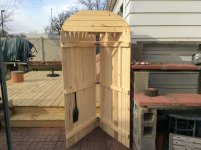Ken-MexiKen
New member
I was planning to, low and slow, a brisket for a pre Christmas party, starting the cook bright and early tomorrow morning. Tomorrow, (Thursday) is looking like a beautiful day, with a high around 57 degrees and light breezes, so no problem cooking. My worry is, a high wind warning, (with gusts as high as 60 mph) is in effect for my area late Thursday night or early Friday morning. We are also in a severe drought here in Albuquerque, so I'm very concerned about any remaining hot embers escaping the Performer kettle overnight and burning down my entire neighborhood. My questions are; Will the kettle contain hot charcoal/embers in a high wind event? Is their any simple or realistic way to extinguish all hot materials when the cook is finished? Should I just wait for better conditions? Any practical advise and previous experiences will be greatly appreciated.
Thanks in advance and Merry Christmas to all.
Ken
Thanks in advance and Merry Christmas to all.
Ken
Last edited:

